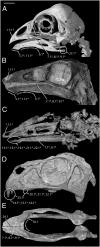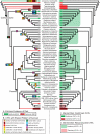Herbivorous ecomorphology and specialization patterns in theropod dinosaur evolution
- PMID: 21173263
- PMCID: PMC3017133
- DOI: 10.1073/pnas.1011924108
Herbivorous ecomorphology and specialization patterns in theropod dinosaur evolution
Abstract
Interpreting key ecological parameters, such as diet, of extinct organisms without the benefit of direct observation or explicit fossil evidence poses a formidable challenge for paleobiological studies. To date, dietary categorizations of extinct taxa are largely generated by means of modern analogs; however, for many species the method is subject to considerable ambiguity. Here we present a refined approach for assessing trophic habits in fossil taxa and apply the method to coelurosaurian dinosaurs--a clade for which diet is particularly controversial. Our findings detect 21 morphological features that exhibit statistically significant correlations with extrinsic fossil evidence of coelurosaurian herbivory, such as stomach contents and a gastric mill. These traits represent quantitative, extrinsically founded proxies for identifying herbivorous ecomorphology in fossils and are robust despite uncertainty in phylogenetic relationships among major coelurosaurian subclades. The distribution of these features suggests that herbivory was widespread among coelurosaurians, with six major subclades displaying morphological evidence of the diet, and that contrary to previous thought, hypercarnivory was relatively rare and potentially secondarily derived. Given the potential for repeated, independent evolution of herbivory in Coelurosauria, we also test for repetitive patterns in the appearance of herbivorous traits within sublineages using rank concordance analysis. We find evidence for a common succession of increasing specialization to herbivory in the subclades Ornithomimosauria and Oviraptorosauria, perhaps underlain by intrinsic functional and/or developmental constraints, as well as evidence indicating that the early evolution of a beak in coelurosaurians correlates with an herbivorous diet.
Conflict of interest statement
The authors declare no conflict of interest.
Figures


References
-
- Weishampel DB, Norman DB. In: Paleobiology of the Dinosaurs. Farlow JO, editor. Boulder, CO: Geol Soc Am; 1989. pp. 87–100.
-
- Barrett PM, Willis KJ. Did dinosaurs invent flowers? Dinosaur-angiosperm coevolution revisited. Biol Rev Camb Philos Soc. 2001;76:411–447. - PubMed
-
- Farlow JO. Speculations about the diet and digestive physiology of herbivorous dinosaurs. Paleobiology. 1987;13:60–72.
-
- Benton MJ. Dinosaur success in the Triassic: A noncompetitive ecological model. Q Rev Biol. 1983;58:29–55.
-
- Brusatte SL, Benton MJ, Ruta M, Lloyd GT. Superiority, competition, and opportunism in the evolutionary radiation of dinosaurs. Science. 2008;321:1485–1488. - PubMed
Publication types
MeSH terms
LinkOut - more resources
Full Text Sources

